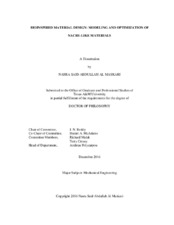| dc.description.abstract | Nacre is an inner layer of seashells that is a tough yet stiff natural composite composed of microscopic mineral polygonal tablets bonded by a tough biopolymer. This type of structure is called staggered structure and it has been observed in other biological materials such as bone and teeth. The high stiffness of nacre is known to be due to its high mineral content. In spite of the high mineral content that is mainly ceramic, nacre exhibit high values of toughness. This high value of toughness is explained by its ability to deform past a yield point and develop large inelastic strain over a large volume around defects and cracks. It has been known that the high strain is mainly due to sliding and waviness of the tablets.
Researchers have been motivated by the structure of nacre and its mechanical properties in order to mimic this natural material to create new engineering composites with superior mechanical properties. However, mimicking nacre’s remarkable properties, to date, is still a challenge. This is due to fabrication challenges, lack of models that captures the important mechanics and difficulties in selecting the best combination of tablets and matrix materials, and system geometry for optimal mechanical performance (e.g., stiffness, strength and toughness) of the staggered structure. Previous attempts to create analytical models for nacre include tablet sliding but don’t account for the waviness of the tablets. In this work, mathematical models for calculating the elastic modulus and toughness of nacre-like material are proposed to account for the waviness of the tablet. In addition, a multi-objective optimization problem is formulated and solved using an optimization method called ‘genetic algorithm’.
Using the models developed in this work, a better prediction of the elastic modulus and toughness are obtained which agrees with experimental results found in the literature. The multi-objective optimization problem solved here results in a set of optimal solutions that the designers can select according to their preferences. This work will aid in the design and optimization of nacre-like materials that can enhance the performance of ceramic materials in different applications in areas such as material science, biomaterials development, civil, petroleum, biomedical and nanotechnology. | en |


